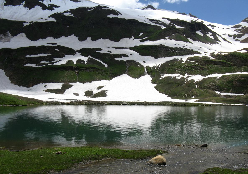Dudipatsar Lake or Dudipat Lake is a beautiful lake encircled by snow clad peaks. The word “dudi” means white and “sar” means lake. This name has been given to the lake because of the white color of snow at surrounding peaks. The lake lies in the extreme north of the Kaghan Valley at N35.0185 E74.0895 and is about a four hour drive from the chief town Naran.
The area receives plenty of rainfall and snowfall where the maximum downpour is during the monsoon months of July to September. Obtaining of fuel/fire wood to meet the needs of heat energy, growing of crops and vegetables, provide feed for the cattle/livestock.
Usually the seasonal population is there the population in the nearby villages is as:
Population: 1,235 people in all; Wealth division: poor = 42%, Middle = 32% and rich 26%
Language: Shina, Hindko and Pushto
Occupation: agricultural planters, rear and herd livestock/cattle, vacationer’s guide/porter/ aide, raise poultry, run private business, employed as private and government workers, work as daily paid workers, skilled and un-skilled professions, gather and harvest timber or highly priced non-timber forest produce for trade, retails in dairy products, receive monthly funds from overseas lands by the relatives, sale of handicrafts, transport sector, fishing etc.
The area is full of alpine flora with a lot of herbs few shrubs and no trees in the area.
The main shrubs and the dwarf trees include Greek juniper (Juniperus excelsa).
The lake has mainly the herbaceous flora including; Rhodiola quadrifida, Himalayan cinquefoil (Potentilla atrosanguinea), Willow herb (Epilobium laxum), Desert anemone (Anemone obtusifoli) andAlpine yellow-violet/Benafshan (Viola biflora) etc around the lake.
The avian fauna welcomed here are the vagrant birds; dropping down for rest and food, also for the resident and migrant birds it offers habitation for breeding. The noteworthy species of 40 recorded at Dudipatsar Lake are; Horned larks, Fire-front serin, Common kestrel, Plain mountain finch, Golden eagle, Brown accentor, Rock pigeon, House sparrow are resident. Winter visitors are the; Citrine Wagtail, Alpine accentor, Rosy pipit, Water pipit, Golden finch, White wagtail, Black red start, Common sandpiper, Himalayan griffon, and Snow pigeon. Rufous-breast accentor, Rock bunting, Eurasian crag martin, Barn swallows and Asian house martin are summer breeders; whereas, Yellow wagtails are passage migrants.
The two known fish inhabiting waters of dudipat lake are; Brown trout (Salmo trutta fario) and Rainbow trout (Oncorhynchus mykiss).
The huge mammals known to have stroll these areas are the; Snow leopard (Uncia uncia), Black bear (Ursus thebitansus), Fox (Vulpes vulpes), Asiatic jackal (Canis aureus), Wolf (Canis lupus) and Rabbit (Lepus spp). Crocidura pullata ,Alticola roylei ,Apodemus rusiges ,Rattus turkestanicus,Mus musculus,Mustela altaica ,Marmota caudate,Hyperacrius fertilis,Ochotona royalii,Marmota caudate,Myotis mystacinus,Rhinolophus hipposideros.
Scincella himalayana (Himalayan Ground Skink), Laudakia himalayana, (Himalayan Rock Agama) Bufo peudoraddei pseudoraddei,( Batura Toad) Laudakia agrorensis,( Caucasian Rock Agama), Spalerosophis atriceps (Royal Diadem Rat snake), Laudakia tuberculata (The Kashmir Rock Agama)
The villagers are chief drawing processes of natural resources here
Area being deficient in any facility of fuel gas supply has led to on the whole use of forest tree wood and use of cow manure as fuel for stoves, pastures for foraging cattle and land for agriculture.
The government is responsible for the management and protection of these resources.
Tourism industry is expanding whereby provides little income source of living, the surrounding is defiled with waste accumulation, noise/water/solid waste pollution, human activities/interruption and transport and foreign inflow of swarming crowds of people in the area is focusing on draining sites modest resources.
Major Issues and Threats
Pressures’ building on this wetland is; solid waste dumps due to tourist activity and that of the resident people; no department takes responsibility for its management. Location is deficient of forest fire management, or any crisis management, gathering in excess of Non Timber Forest Products (NTFP) such as the herbs with therapeutic features, vegetables and dried nuts; grassland is ignited with fire to produce a good greener grass where it completely destroys the generating younger trees, augmented needs of fuel/fire wood destroys the natural habitat and tourism imperils it greatly which is without any administration in charge for sites, improvement, safety or healthier state.
Recommendations
- Promote eco-tourism with seriousness and consciousness with knowledge of the importance of unique and fragile biodiversity and mountain ecosystems’
- Monitoring and checking of the area should be strictly done to prevent overgrazing and wood cut for fuel use.
- Alternate means of energy be introduced and installed to prevent and discourage draining of natural resources e.g. wind/water/solar
- Appoint and involve schools, colleges, religious schools and representative/caretakers of the land, to participate through regular organized activities designed in every respect for saving the environment
- Unfailing and serious efforts should be made for awareness, education, research and publicity of the wetland.
- Promote eco-tourism with seriousness and consciousness with knowledge of the importance of unique and fragile biodiversity.
- Train people how to enhance the environment by taking it as individual responsibility and play a part in betterment of the sensitive environment.
- Pollution due to tourist activity be prevented, by putting up billboards of notices of not disposing waste in the area, hefty fine should be kept as penalty.
- Encourage and involve community to help prevent pollution of the lake it self
- Educate the community on the importance of biodiversity and sustainable use of resource.
- Prevent human activity in the wildlife rich areas by constant patrolling, checks and monitors





